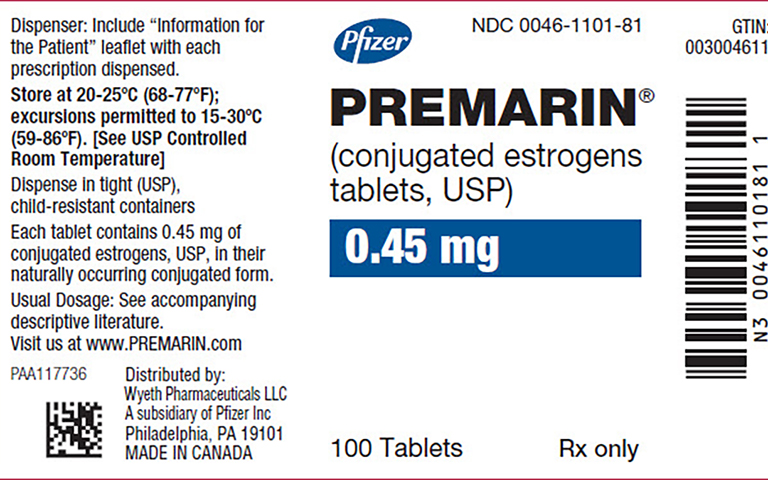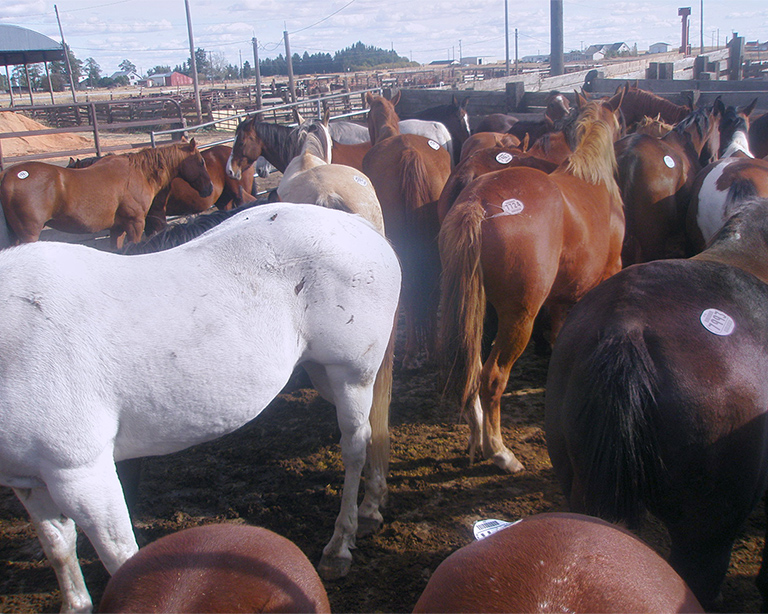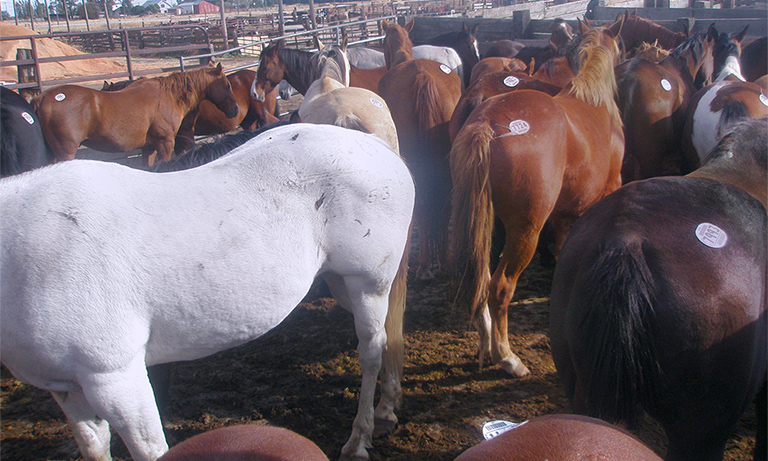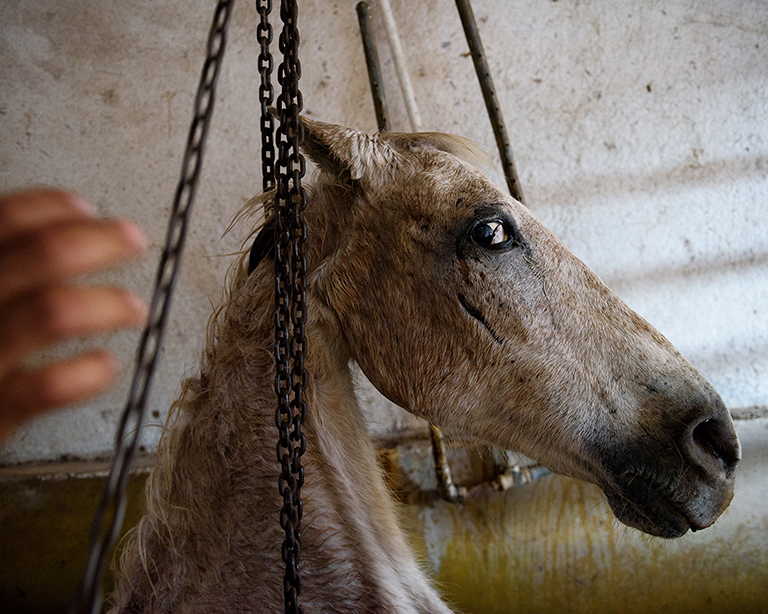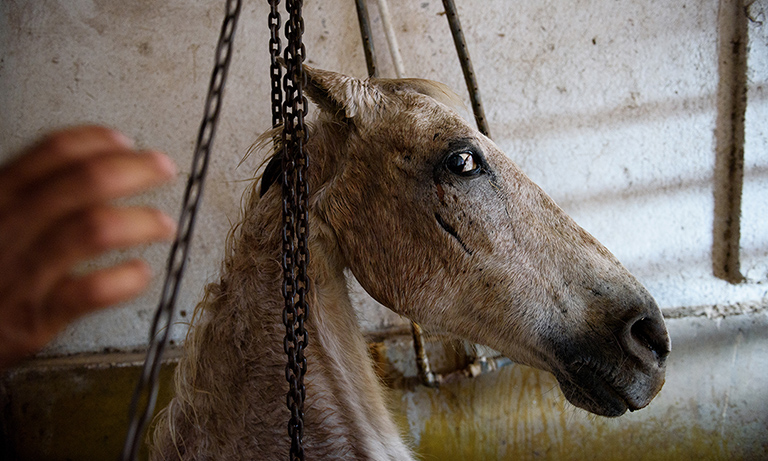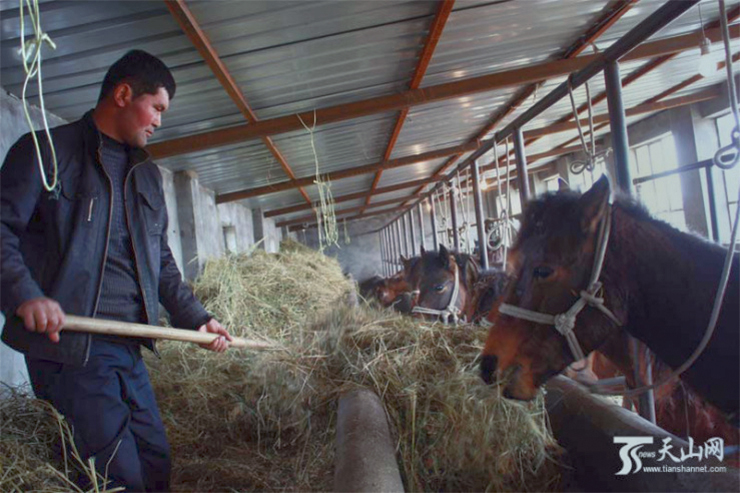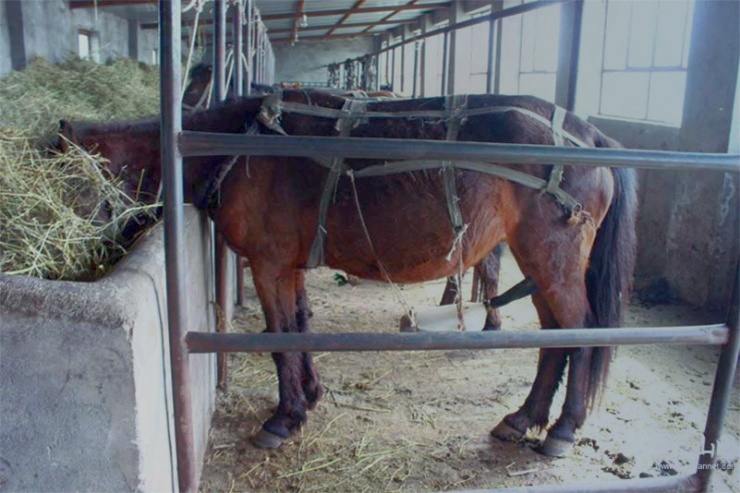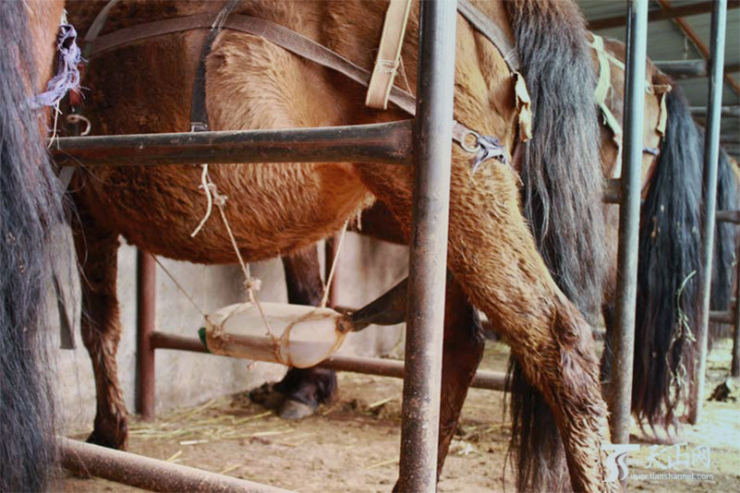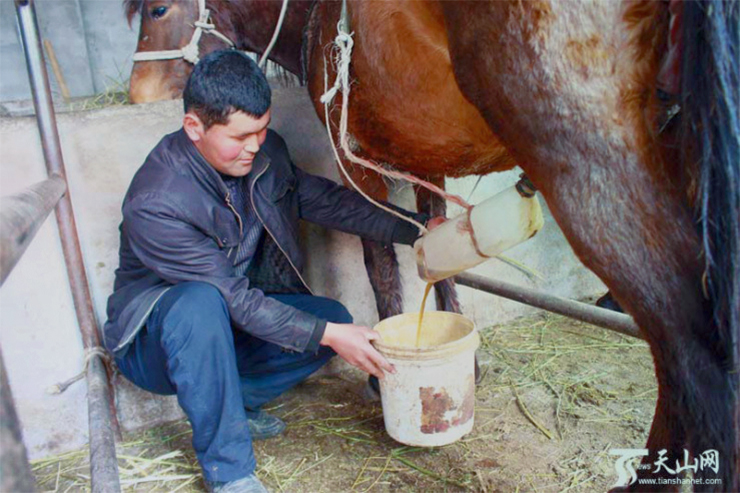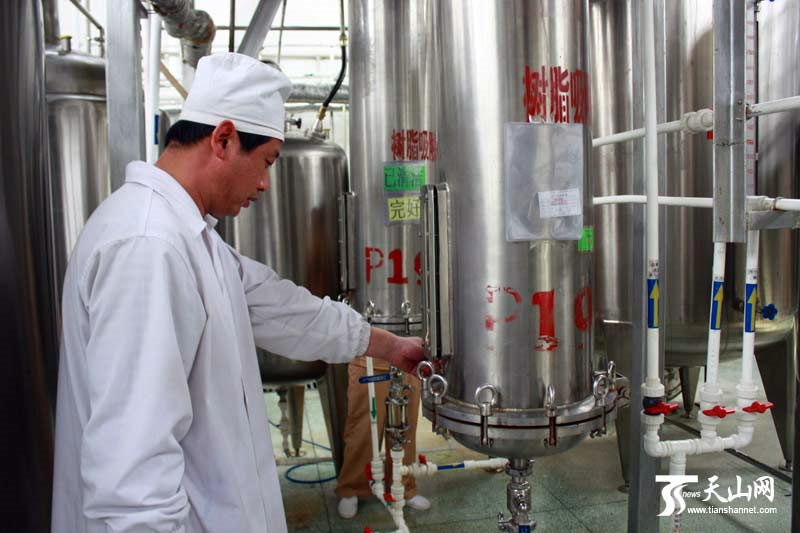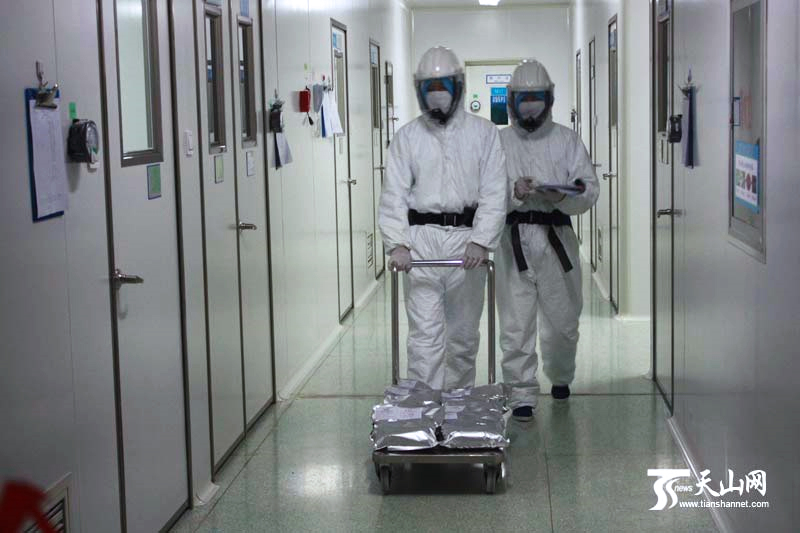Yep, Horse Pee.
It's right there in the name: Premarin® = PREgant MAres uRINe. Pfizer-Wyeth's lineage of hormone replacement therapy (HRT) drugs features not just Premarin, but also Premplus, Prempro®, Premphase®, Provera® and Duavee®. The estrogenic element comes from the urine of constantly impregnated mares. When too worn down to produce, spent mares (and their unwanted foals) are sold to killer-buyers in the horse slaughter trade. Conjugated equine estrogens (CEEs) in drugs have been marketed to menopausal women in the U.S. since 1942.1
- The United States annually exports tens of thousands of horses to Canadian and Mexican kill plants. PMU farms in Canada, China and more countries outside the U.S. sell innumerable mares and foals for slaughter across Europe and Asia.
- American Horses Slaughtered in Mexico for Meat: Investigation by Animal Equality
To acquire Premarin's “complex blend of natural estrogens,” hundreds of thousands of pregnant horses stand on pee lines. But you won't find urine listed on the bottle of this 60-year old hormone replacement therapy. In fact, experts are hard-pressed to classify the mystery stuff inside Premarin®, Prempro®, Premphase®, Provera® and Duavee®. “Because it is animal based, we don't know exactly what's in it… and you can't tell the horses what to pee,” asserts Dr. Alan Altman, Harvard Medical School's assistant clinical professor of obstetrics, gynecology and reproductive biology. Turns out even U.S. Food and Drug Admin (FDA) questions consistency of estrogen extracted from horses going potty. Estradiol yield alone can fluctuate nearly 400% from batch to batch.
Seems nature doesn't intend for human women to have horse piss cursing through their bodies. Humans make 3 hormones — estradiol, estrone, estriol — that are managed by human enzymes and cofactors scaled to the human body. People-version estrogens occur in a ratio of about 7% estradiol, 3% estrone and 90% estriol. Premarin doesn't even come close to a match. It contains estrone (75-80%); equilin (6-15%); estradiol + two other equine estrogens (5-19%); along with other estrogens incongruous with human systems. How is it a good idea to flood human bodies with horse stuff? This potion of mismatched estrogen ratios and horse estrogens can trigger hormonal imbalances that over time lead to heightened risk for: breast, uterine or endometrial cancers; dementia; blood clots; strokes; heart attacks. Bottom line? Equine estrogens function safely in horses. But not in people.2, 3
- Women's Health Initiative (WHI)National Institutes of Health (NIH): When results for the largest randomized study of its time become available, they don't look good. The landmark WHI research links long-term Premarin use to accelerated risk for stroke and blood clots. Prempro use is tied to heart disease and breast cancer. On 7/9/02, NIH abruptly halts its risks/benefit assessment of long-term Prempro and Premarin use after women suffer coronary heart disease, breast cancer and stroke, undetected in animal experiments.4, 5 The government issues a cautionary letter about the drugs' potentially fatal hazards. The news shocks some 9 million women on HRTs for menopause symptoms and osteoporosis.
“Thanks to my late father, a drug made from animal waste is the most widely prescribed drug in the world today. Premarin has a secret ingredient that my father had no trouble accepting: animal suffering.” Ron Wilson, son of Dr. Robert A. Wilson, who dubbed menopause a “living decay” and touted estrogen drugs as vital in the pursuit for the timeless woman - PMU FarmsPregnant Mare's Urine: Mares are re-impregnated within days after each birth so their bodies continually produce estrogen in the last six months of each cycle. Mares are harnessed in fixed positions with limited exercise. Unable to shift direction or recline with ease, many suffer bloated, painful legs and exhaustion. Rubber urine-collection bags strapped over their urethras lead to leg chafing and infected sores. To harvest urine with a high consolidation of estrogens, farmers withhold drinking water. Renal and liver disorders are widespread among PMU mares.
NORTH AMERICA: A once robust industry with 55-60,000 mares on pee lines in the late 1990s, North American numbers have since plunged. There are no PMU farms left in the United States. NAERIC's (North American Equine Ranching Information Council) 2023 tally shows just 12 equine ranches under Pfizer contract in North America — in the Canadian provinces of Manitoba (9) and Saskatchewan (3).6 Still, Premarin products (conjugated equine estrogens, CEEs) remain among the most prescribed drugs for menopause and osteoporosis worldwide. An astonishingly high number of patients and doctors are oblivious to their cruel origin.
CHINA: PMU collection shifts to China, where pee farms go unfound for over a decade before fully exposed in 2016. Xinjiang Xinziyuan Biological Pharmaceutical Co., Ltd. is both competitor and partner with Pfizer-Wyeth. The Chinese PMU giant — located in northwest China's Nilka County, within the Ili Kazakh Autonomous Prefecture of the Xinjiang Uygur Autonomous Region — seeks worldwide dominance in breeding/sales of pregnant mare's urine, with Pfizer as its main contractor. PMU farms are a “sunrise industry” in rural China, where 90,000 (and growing) horses pee for Big Pharma's secret HRT ingredient: conjugated equine estrogen (CEE).7 - The Fate Of Foals And Mares: Big horses (such as a Belgian-Quarter Horse mix) are prized for their large bladders on Premarin pee lines. Rubber urine-catch bags, strapped to mares 24/7, abrade skin and cause lesions. Horses are stall-confined throughout their 11-month pregnancies. They face one direction, unable to turn or advance more than a step in any direction. Mares leave pee lines a few months pre-birth and are permitted to nurse foals till weaning age at 4 months. Then foals are removed; mares are recycled for impregnation.
When the mares’ bodies are too used up to get pregnant again, their next stop is the slaughterhouse. Spent mares, and their foals, are among tens to hundreds of thousands PMU castoffs who wind up at auctions where most are sold to feedlots to fatten them for the overseas horse meat trade. In Europe and Asia, prime equine cuts go for $25+ a pound. Foals born throughout pregnancy cycles have less monetary value than the pee their moms produce. The odds that a filly foal will skip slaughter for better days are less than 1-in-10. A relative few are raised as replacement mares for PMU barns. Colt foals aren't that “lucky,” with less than 1-in-50 odds of refuge from slaughter.
“See, the foals — and the mares which [sic] can't get pregnant any more — they are the byproduct of the PMU industry … We crush ’em and recycle ’em, just like [aluminum] cans.” PMU industry insider7
Mares and foals are trucked from auction to slaughterhouse in double-decker livestock trailers. They're overpacked with a perilous mix of stallions, geldings, mares, miniature horses, thoroughbreds, draft horses, ponies, donkeys, and mules. When fighting erupts, “the killer-buyer may wrap the horse's muzzle with duct tape or bailing wire,” writes Cheryl Kucsera in Premarin and Horse Slaughter: The Hidden Story. “Often, unruly horses are deliberately blinded by gouging out their eyes or shooting them in the eyes with a BB gun.” During grueling treks, horses travel without food, water, or refuge from weather extremes.
- Last Stop Is The Slaughterhouse: Ambulatory animals dismount first. The dead and dying are hauled from trailers in chains. The killing room reeks of death, with dazed and moaning horses in full view for newcomers. A frantic horse is prodded from her narrow chute through the knock box door. Staggering over blood, urine and manure, she struggles to balance as workers fire a metal shunt into her brain. She may need two or three shots from the captive bolt gun before she passes out. Next, she is cast onto a conveyor belt, bound by a hind leg, and suspended upside down in the air. She remains alive, sometimes regaining consciousness, as her throat is slit. To render meat for human ingestion, the horse's pulsating heart must pump blood from her body. See investigative footage from the horse meat trade: Shocking Torture Of Horses Slaughtered To Be Sold As Beef. Horse slaughter is the end of the line for most PMU mares and foals: Undercover footage shows tiny ponies slaughtered for their meat in British abattoir
For every 150 women who replace Premarin HRT products (conjugated equine estrogen, CEE) with plant-based BHRT (bioidentical hormone replacement therapy) or other naturopathic remedies for menopausal symptoms — one less mare endures the pee line. Seven or eight foals don't become someone's dinner.
Life On The PMU Farm
Life On The Farm
P IN PREMARIN = PAIN
Assembly-Line Production. Premarin industry mares are forcibly impregnated to generate high-estrogen urine. During 11-month pregnancies, they're restrained in stalls 3.5 ft. wide by 8 ft. deep — leaving a 2300-pound pregnant draft mare barely enough room to stand, let alone move or extend her legs for circulation. Horses stand upright (day and night) in cramped stalls, alongside each other in row after row. They are denied all natural instinct to shift, walk, run or lie down for rest and sleep. They cannot graze or roam pastures, innate behaviors for horses. This brutal cycle of forced pregnancy-to-pee-line repeats over and over, until their bodies give out. No laws mandate how horses are treated. Pfizer-Wyeth follows a code of practice under its self-created North American Equine Ranching Industry Council (NAERIC). The drugmaker regulates its own farms for compliance with code.
Pee Machines. A mare's head is bound so she can't lay down. A urine collection cup is affixed around her other end. Dirty clunky tubing, entwined in straps, encases her body 24/7 to trap urine. This crude set-up keeps her immobilized, with chafing, urine-coated sores and trapped feces. Mares are deliberately dehydrated, denied ample drinking water, to consolidate hormones in their urine. “[Wyeth] claims the water restriction policy has been modified; however they are unwilling to give humane organizations access to farms to verify such changes” (Humane Society of the U.S. 2007).
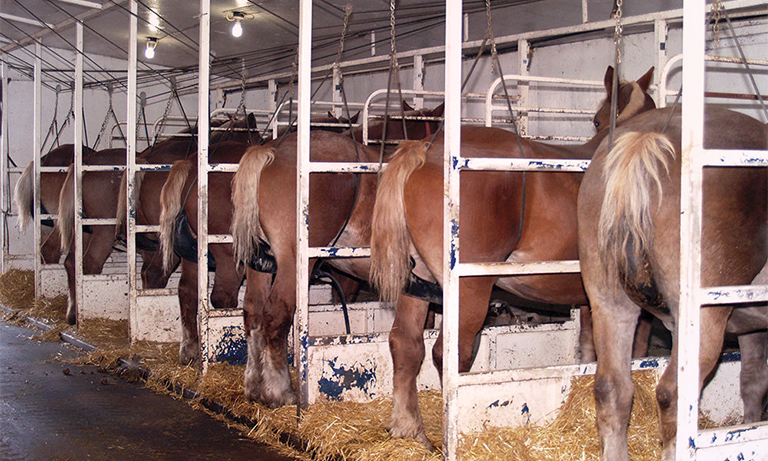
Cheap Wretched LivesTo cut cost and staff for clean-up, Premarin mares stand upon rigid concrete floors, minus any suitably plush straw bedding. Life inside sparse, cold enclosures leads to hoof wounds, chronic pain and arthritis. It's easier to replace estrogen-producing mares than fund veterinary medical care, so horses live an average 4 years, deprived of normal motion and exercise. Though crammed together in pee barns, PMU mares are isolated from one another in barren stalls. Their instinctual need for herd sociability is ignored.

- Dehydration
- Hoof injuries
- Leg wounds, sores, arthritis and lacerations
- Reproductive organ damage
- Swollen joints
- Edema
- Liver disorders
- Kidney failure
- Premature death
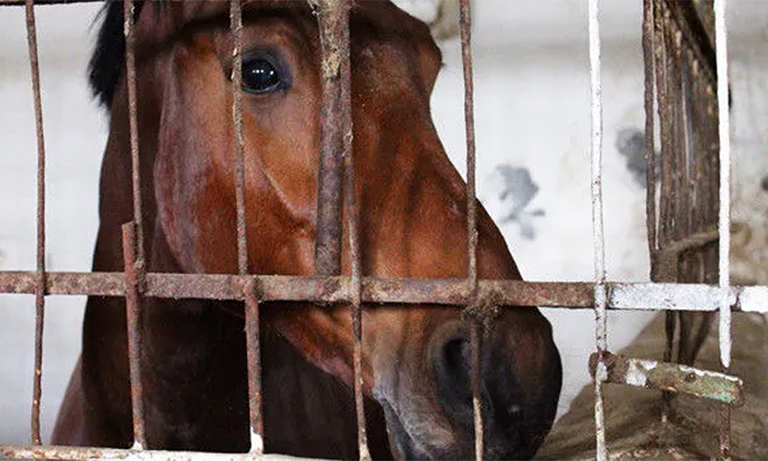
Spent MaresPremarin mares are bred non-stop over their brief lives. Eventully, their reproductive organs rupture under the weight of gravity. Daily overuse, negligence and abuse — plus an upright posture with no chance for rest — cause organ displacement and failure. Once they collapse, there is no coming back. Debilitated mares can't get pregnant or carry to term. They are worthless on pee lines, so farms sell them for slaughter. PMU mares feed the horse meat pipeline from killer-buyers to foreign kill plants. Their flesh is sold as high-end cuisine in Europe and Asia.

SeparationNewborn foals are taken from mothers. Some PMU ranches claim to let mares nurse foals about 4 months, till weaning age. Either way, the baby horses are fattened in feedlots before sold to slaughterhouses for horse meat. At separation, mares instinctually defend their children. Ranchers whip, kick or batter them into submission with electric prods. The bond between mare and foal is stolen from PMU horses. They live as baby-making machines, to pee out estrogens that women ingest as Premarin, Premplus, Prempro, Premphase, Provera and Aprela.

Transport HellForeign kill floors await used-up Premarin horses. To reach kill plants, horses travel hundreds of miles stuffed into trucks or double-decked cattle trailers that hurt their heads and necks. Food, water and rest are withheld for 24 or more hours. Horses arrive weak and injured. Some are dead by journey's end. Others are kept in over-packed trailers for days at the plant, enduring hot or cold weather extremes. Horses who collapse are brutally offloaded, shoved down chutes, dragged and mishandled.
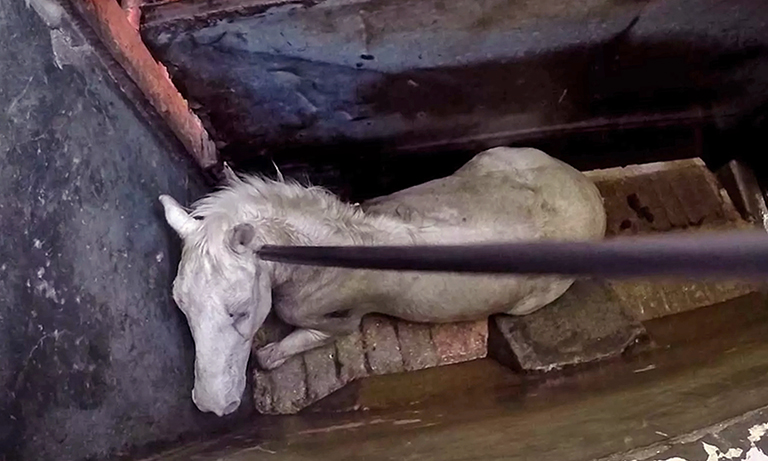
Killing FloorsSlaughter is excruciating for these easily excitable animals. Horses are goaded into the kill box with fiberglass rods. Workers pummel their faces, necks, backs and legs. They thrash in pain when captive bolt pistols (used in Canada) fail on the long-necked animals. In Mexico, killers use a puntilla knife to sever a horse's spinal cord. Investigative reports show alert horses stabbed repeatedly around the withers. When a horse finally falls, he is merely paralyzed as workers dangle him by his hind leg and slit his throat. Some horses even remain sentient when dismembered.9
The Premarin Journals
The Premarin Journals
HUMANS AND HORSES
1942 – 1943 » In 1942 Ayerst (the forerunner to Wyeth( gets patent consent for Premarin, made from pregnant mares' urine. FDA green-lights Premarin as a replacement therapy for decreased estrogen levels in women. By 1943 Wyeth, now merged with Ayerst, McKenna and Harrison, Ltd. Of Canada, debuts Premarin®, as the first conjugated (equine) estrogen drug in the world. The Journal of Clinical Endocrinology lauds Premarin for its efficient relief of menopausal symptoms.
1965 » Dr. Robert Wilson writes his infamous book Feminine Forever about the miracle “cure” of estrogen replacement theory (ERT) and HRT to treat menopause as disease. The public is unaware that Dr. Wilson is a consultant for Wyeth.
1972 – 1973 » A FDA Federal Register notice declares estrogen drugs like Premarin as beneficial remedies for menopausal symptoms. The agency facilitates submission/approval of new drug applications (ANDAs) for generic conjugated estrogens. In 1973, with estrogen hailed as a panacea for heart health, men take Premarin in a clinical trial. The study quickly ends when men actually suffer more heart attacks and blood clots. Rather than red-flag Premarin's injurious effects, researchers blame dosing problems and maintain praise for the drug's use in menopausal women.
1975 – 1977 » 1975: New England Journal of Medicine (NEJM) posts two articles that show post-menopausal ERT ups risk for endometrial cancer by 4-14 times. 1976: Ayerst markets physicians nationwide with “Dear Doctor” letters. FDA berates the letters as deceptive and issues a bulletin about the risk for uterine cancer linked to conjugated equine estrogens. NEJM releases its first review on the connection between estrogen intake and breast cancer. 1977: Premarin's tie to uterine cancer is confirmed. Ayerst adjusts labels with a warning, but considers this merely a public relations challenge. Premarin rises to fifth place among most prescribed U.S. drugs, with 30+ million scripts.
1980s » 1982: Cancer research journals pinpoint CEE hormones as a key cancer indicator. 1987: Investigative footage exposes PMU horse abuse for the first time. Equine Time News (1988 Fall/Winter) publishes atrocities such as dead and mutilated horses, farmers who brutalize horses for no apparent reason, horses with missing limbs or hooves separated from limbs… 1989: A Swedish study in NEJM reveals that women on estrogen-progestin combo therapy are at double the risk for breast cancer.
1991 – 1995 » Across the 1990s, Premarin is the most dispensed drug in the U.S. 1991: Women join the largest randomized study to date, Women's Health Initiative (WHI). The trials analyze impact of postmenopausal drugs like Premarin, diet, calcium and vitamin D intake on heart disease, fractures, breast and colorectal cancer. 1995: Prempro® joins the Premarin portfolio as the first estrogen-progestin FDA-approved HRT drug. NAERIC (North American Equine Ranching Council) is formed as a coalition of ranches that collect pregnant mares urine (PMU). NAERIC is mostly Wyeth-funded and endorses horse slaughter.
1997 – 1998 » Premarin is Wyeth-Ayerst's first brand to achieve $1 billion in sales. FDA rejects smaller company appeals for a Premarin generic. Wyeth and FDA campaign against Premarin generics, citing user safety. In fact, no Premarin generic exists due to Wyeth lobbyists and political motivation. The Lancet (UK med journal) shares 51 epidemiological studies that further verify the link between breast cancer and post-menopausal estrogen intake. 1998: A pioneering placebo-controlled trial shows HRT offers no defense against heart attacks. Instead, estrogen drugs spike risk. Participants withdraw from the study.10
2001 » Early results from the big WHI study trickle in. Physicians are ambivalent about data on breast cancer and heart attacks. Wyeth shares fall 19% on Wall Street. The drugmaker assures people that only Prempro is in the spotlight, not Premarin.
2002 » On the heels of the Women's Health Initiative (WHI), a huge federal study conducted over 14 years, National Institutes of Health advises pysicians to stop scripts for conjugated equine estrogen (CEE) drugs. During WHI clinical trials, the WHI Observation Study monitors medical backgrounds and health habits of over 93,000 postmenopausal women, ages 50-79, for eight years.11 But government scientists call stop when data shows long-term estrogen-progestin intake notably magnifies risk of breast cancer, strokes, heart attacks. WHI findings trigger anxiety in HRT users and new restrictive prescriptions. Prempro usage swiftly drops from 6 million to 3.3 million and sales plunge 32%.
2003 » More NIH-WHI data reveals that HRT advances dementia. Continuing studies, further implicate Prempro in cardiovascular events and breast cancer. Though FDA never recalls Prempro or Premarin, the agency mandates warning labels about risk of heart disease, stroke, breast cancer, pulmonary embolisms and blood clots. Wyeth carries on amid media reports that not only expose HRT's toxic effects on women but also PMU farms — where relentlessly impregnated mares are restrained in pee barns, their foals slaughtered as leftovers.
2004 » In the shadow of the NIH-WHI study, about 350 PMU farms lose contracts, Wyeth faces multiple lawsuits, and sales drop by 60%.Thousands of horses on 700 pee farms go to slaughter. Animal rescues save some horses. Premarin and Prempro nosedive: $1.3 billion in 2002 to $880 million in 2004. Wyeth tries to re-brand itself with a lower-dose estrogen-progestin duo for enhanced safety. The NIH-WHI study's estrogen-alone (Premarin) segment progresses till 2004, then also ends hastily due to high risk for stroke and deep vein thrombosis, plus zero evidence that Premarin guards against coronary heart disease.
2005 » As Prempro sales decline 76% and Premarin 47%, Wyeth shuts down a plant and cuts 15% of its sales staff. Oct 2005: Wyeth claims bioidentical hormone replacement therapy (BHRT) is unsafe and violates manufacturing standards in a petition that asks FDA to ban emerging competition with their synthetic hormones.
2007 » State courts close America's last three equine processors in Texas and Illinois. But the lack of a federal law lets over 100,000 horses go to slaughter in Canada and Mexico in 2008. Animal protection advocates lobby Congress to pass the American Horse Slaughter Prevention Act to outlaw horse export for slaughter. PMU herds are cut everywhere as buyers of PMU-formulated drugs void contracts. The UN's International Agency for Research reclassifies HRT from “possibly carcinogenic” to “carcinogenic.” A paper in The Lancet shows HRT ups risk for ovarian cancer by 20%. FDA says “not approved” to Wyeth's non-hormonal menopause drug Pristiq until more research proves it does not cause severe heart and liver conditions.
2008 – 2009 » Wyeth convenes with FDA for approval of its new horse-pee drug Aprela to treat menopause and osteoporosis. Aprela is estimated to increase demand for pregnant mare's urine by 4.5 times. 2009: About 5600 mares still pee for Wyeth. They're kept on 73 contract farms, mainly in Canada, where Wyeth won't let surplus horses go to rescue.12 Almost 1 in 4 foals die of starvation or exposure, a Canadian Veterinary Journal reveals.13
2009: Drug czar Pfizer buys out Wyeth, to form the world's biggest pharma firm. The Pfizer-Wyeth P.R. arm tries to dispel HRT danger, despite an ocean of scientific evidence against the drugs. Public records disclose that Wyeth funds ghostwriters for 26 HRT papers, exemplifying how Big Pharma exploits medical writings for profit.10
2010 » More surveys implicate HRT as a risk factor for asthma, lung cancer, malignant melanoma and reduced insulin resistance. Wyeth (bought out by Pfizer) battles lawsuits about use of Premarin and its siblings that span from 1976 onward. Some 5000 cases alone are breast cancer focused. Still, Pfizer Q4 Biopharmaceutical earnings boast a 30% spike at $24.6 billion, compared to $11.2 billion in Q4 2008. Pfizer-Wyeth anticipate sales over $1 billion by 2015, for Premarin and Aprela. Even as profits rise, Pfizer-Wyeth closes eight plants, with 6000 job lay-offs at six others. Wyeth begins to trim PMU ranches, with projected closure of 39 sites. In fact, the drug giant seeks new locales where societies consume horse meat. The Western Producer reports: “Wyeth plans to ramp up production of PMU facilities in China, Kazakhstan and Poland, out of the scrutiny of North American values. The byproduct of meat foals has a lucrative market, while Wyeth can continue to make statements relating to supply and demand to justify price of HRT.”14
2011 » Wyeth-biased research urges doctors to prescribe more HRT at younger ages, rather than restrict disputed Premarin family drugs. Such marketing contradicts past studies that show elevated breast cancer risk in early-use patients. Oh well… Meanwhile, Pfizer hosts a teleconference on “solutions to the unwanted horse problem.” Tom Lenz, Senior Director of Equine Veterinary Services at Pfizer Animal Health — a known defender of horse slaughter — leads the call. Pfizer, in alliance with North American equine groups (AQHA, AAEP, AVMA, UHC, UOH, NAERIC, AHC), casts horse slaughter as the “humane” answer to spent mares and unneeded foals. Oct 2011: New Jersey state court is home to 150 HRT lawsuits, though an appeals court dismisses claims that Prempro, Provera and Premarin fail to warn users about breast cancer risk and delude federal regulators.
Expanded WHI research at Buffalo University indicates that conjugated equine estrogen obscures breast cancer detection, allowing the disease to progress to lymph nodes and lower survival rates. The study also links estrogen to kidney stones regardless of other risk factors such as age, ethnicity, weight. Alongside bad-news data, Pfizer muddles through lawsuits with 52% of HRT actions still open as of 12/31/11. The pharma
behemoth incurs $336 million in 2011 and $300 million before that. Another $359 million, to cover nominal costs for unsettled HRT suits, is paid out in 2011. Jan 2011: A woman in Puerto Rico gets $1.5 million for claims that Prempro caused her breast cancer. Feb 2011: A Prempro breast cancer case garners more than $10 million for litigants in Pennsylvania. Jun 2011: Pfizer owes $58 million to three women who sue the company's Wyeth division over breast cancer diagnoses. The U.S. Supreme Court denies Pfizer's appeal. Dec 2011: Pfizer is slapped with a $72.6 million verdict for three Philadelphia women who develop breast cancer after HRT use.15
2012 » Pfizer seeks U.S. clearance to market Aprela, a newer mix of Premarin and bazedoxifene — a Selective Estrogen Receptor Modulator (SERM), with brand name Viviant, to deter postmenopausal osteoporosis. But Viviant is stuck behind FDA gateways due to heightened risks for stroke and thromboembolic incidents. If greenlit, Aprela intends to overshadow Prempro and Premarin, both tainted by raised cancer and cardiovascular risks. Pfizer predicts sales in the $1 billion range by 2013.
2/17/12: With Premarin's patent set to expire, Pfizer joins forces with Zhejiang Hisun Pharmaceutical, a top pharma firm in China, to manufacture off-patent drugs in global markets. PMU farms have operated in Northern China for 8 years by now, coinciding with WHI's breakout findings about health risks from CEE-based HRT. Wyeth, with knowledge their lucrative Premarin line boosts chances for breast cancer, cardiac disease and more, appears to transfer PMU farms offshore to avoid public backlash.
4/1/12: The Nurse's Health Study (NHS), with data recorded from 1980 to 2008, shows women on estrogen and progesterone (Prempro) are at 88% greater risk for breast cancer after 10 years on the drugs. A decade of estrogen use alone intensifies breast cancer risk by 22%; the risk jumps to 43% at 15+ years. May 2012: Massachusetts General Hospital (Boston) research affirms NHS findings that tie postmenopausal HRT to ulcerative colitis, with a 1.7 higher rate of this colon/rectum disease. Around the same time, Pfizer downsizes it mass estrogen extraction plant in Brandon, Manitoba with plans to cut staff by 40% in 2013. Other pharma firms jump in to nab the generic Premarin market, with contract bids for PMU ranches at sites that Pfizer abandons. Lawsuits carry on, amid mounting evidence of pee-based HRT's adverse affects. Pfizer pays $896 million to cover 60% of patient suits (some 6000 cases) with $330 million reserved for Prempro liability (about 4000 suits). Pricetag: $1.226 billion for 10,000 cases. Yet even as damages are paid out to Premarin/Prempo sufferers, 15 top medical entities — North American Menopause Society, American Society for Reproductive Medine, Endocrine Society, American Academy of Family Physicians, etc. — issue a message to restore faith in HRT. No worries, PMU drugs are “acceptable” and comparably “safe.” By now, health hazards related to PMU HRT are well documented. 7/31/12: Newark, CA based pharma company Depomed Inc. submits a New Drug Application (NDA) for Serada™, a non-hormonal remedy for hot flashes with less adverse reactions. 8/29/12: Noven Pharmaceuticals seeks FDA approval for low-dose mesylate salt of paroxetine, LDMP, to alleviate vasomotor symptoms (hot flashes, night sweats). Both treatments, free of pee from abused horses, mark a turning point. At the time, pregnant mare's urine HRT is the only FDA-endorsed therapeutic for menopausal hot flashes.16
December 2013: Horse Urine A Profitable Industry In China airs on BONTV, verifying Int'l Fund for Horses disclosure about transfer of most North American PMU ranches to China.
2013 » Jan 2013: Pfizer minimizes Prempro's threat of breast cancer, a theme behind ongoing lawsuits. The company has settled 60% of 10,000 claims thus far. 3/4/13: U.S. FDA Reproductive Health Drugs Advisory Committee rejects promising non-hormonal drugs Serada and LDMP. HRT from pregnant mare's urine remains the sole single-agent drug for menopausal symptoms. May 2013: A French National Institute For Health analysis links estrogen pills to heightened risk for gallstones that require gallbladder removal surgery. Data is logged from 70,000 females in France, 1992 to 2008. Jun 2013: FDA greenlights Bisdell, the first non-hormonal therapy for hot flashes. Originally rejected under brand name Sereda, the drug's primary ingredient is paroxetine mesylate, a selective serotonin reuptake inhibitor. Sep 2013: A Group Health Research Institute study shows estradiol (bioequivalent estrogen) triggers far less harmful vascular effects than conjugated equine estrogens (Premarin). Specifically, estradiol users are not at high risk for leg vein blot clots (deep vein thrombosis) and lung clots (pulmonary emboli). Premarin users are.
10/3/13: Pfizer-Wyeth's Duavee (formerly Aprela) gets FDA approval, despite safety concerns for its dual-acting components. Bazedoxifene alone lacks U.S. authorization; it boosts risk for stroke, deep vein thrombosis and retinal thrombosis. Premarin is classified as a carcinogen, with longstanding research to show it amplifies chance for stroke, heart attack and breast cancer. By year's end, 95% of Prempro/Premarin legal actions are settled, with Pfizer out $1.6 billion. Though lawsuits demonstrate how Pfizer-Wyeth dupes consumers about risks tied to their CEE/Premarin drugs, the company robustly markets its noxious products.17
2014 » Menopause-osteoporosis drug Duavee hits drug markets, but with stipulations. Pfizer must carry out post-marketing pharmacokinetic trials to assess how conjugated equine estrogens (Premarin) + bazedoxifene (Selective Estrogen-Receptor Modulator) may cause hyperplasia, a predecessor to endometrial cancer. For unknown reasons, FDA okays Duavee a full year before trials for cancer risk are completed (4/2015).18 With declining Q1 profits and no breakout new drugs, Pfizer aggressively markets Duavee19, along with Premarin tablets and vaginal cream. Lawsuits are consumers only recourse. One class action suit in Canada amasses formerly unexposed evidence linking Premplus to invasive breast cancer. Pfizer dismisses Canadian Cancer Society research that shows drugs with equine estrogens induced breast cancer in thousands of Canadian women. 10/27/14: European Medicines Agency (EMA) approves conjugated equine estrogen + bazedoxidfene, sold as Duavine. U.S. version Duavee climbs $100 million in sales with 5000 monthly scripts… NAERIC (North American Equine Information Council) lists 2000 mares still warehoused on PMU farms. By now, peeing for Premarin occurs offshore in China and likely India. No precise horse count exists, but Asian PMU sources far exceed those in North America. Pfizer launches vigorous new campaigns. They target 50-something women about painful intercourse and vaginal atrophy with celebrity sex-and-aging ads. Kim Cattrall of Sex And The City fame and Desperate Housewives’ Brenda Strong are among stars who hawk horse-pee drugs, including Estring — an estrogen-release vaginal ring.20, 21
2015 » Unbiased, scientific studies, rather than Big Pharma, finally begin to influence menopause therapy. The Guardian newspaper's pioneering report Women Have Been Oversold HRT For Decades chronicles how HRT is sold as the miracle meno-cure for cardiovascular disease, dementia, stress incontinence, hair loss, need for dentures, osteoporosis, depression and a sluggish sex life — since Robert A Wilson's 1966 book Feminine Forever. “For 10,000 people-years of taking HRT, there were 15 more heart attacks or strokes, eight more pulmonary emboli (blood clots to the lungs) and eight more breast cancers. An analysis published in the Lancet found that for every 1,000 women using HRT for five years, there is one extra case of ovarian cancer, a higher risk than seen in previous studies.”22 5/9/15: Collaborative Group On Epidemiological Studies Of Ovarian Cancer publishes Menopausal Hormone Use and Ovarian Cancer Risk: individual participant meta-analysis of 52 epidemiological studies.23, 24
2016 » Estrogen taken from continually impregnated mares (Premarin, Prempro) is sourced in cruelty. PMU mares are restrained on pee lines to collect horse estrogens in their urine, ultimately ingested by humans. Spent mares and their foals are discarded as trash, routinely auctioned off to kill-buyers for slaughterhouses and foreign horse meat markets. Countries that consume the most horse flesh (2018-2023) include: China, Kazakhstan, France, Switzerland. Top horse meat producers are China, Kazakhstan, Mexico, Mongolia, Russia, United States, Canada, Brazil, Australia, Kyrgyzstan.25, 26 The Big Premarin Lie? Pfizer labeling does not say equine, as in: “conjugated equine estrogens (CEEs)”. Pfizer knowingly removes equine from Premarin, Prempro, Duavee… labels and instead calls its active ingredient: “conjugated estrogens.” U.S. Food and Drug Admin allows this mislabeling to occur, even though World Health Organization cites CEEs as known carcinogens. Conjugated estrogen may also come from plants. The root component in Premarin comes exclusively from horses. Premarin = PREgnant MARe's urINe.
China now appears to do the biggest business in Premarin-style drugs, with an Asian copycat drug in mass production there. Xinjiang Xinzi Biopharmaceutical Limited Liability Company sources horse pee into estrogen drugs, declaring itself as one of two companies worldwide to do so. The other company? Pfizer-Wyeth, of course. Jane Allin, Chief Research Analyst for Int'l Fund For Horses and regular contributor to Tuesday's Horse writes in Pfizer Consigns PMU Horses To Killing Fields Of Asia, “If anyone believes that the downsizing of the PMU industry here in North America is advantageous for the mares and foals who suffer at the hands of Big Pharma, they are sadly mistaken.”27
2017 » More non-estrogen remedies compete with Pfizer-Wyeth in the menopause field. Feb 2017: AMAG Pharmaceuticals nabs rights to Intrarosa, an estrogen-free treatment that touts safer profiles than Premarin cream and Estring vaginal ring. Intrarosa's key component is the hormone precursor prasterone. “This drug is a steroid, of which estrogen is a metabolite… So basically it's just another form of estrogen that isn't derived from horse pee. Safer but still has risks associated with estrogen. It would be nice if the pharmaceutical companies could come up with something that isn't a steroid/estrogen. But that's all they seem to know — and because it's easy” (Jane Allin, horse advocate and expert on drugs formulated with pregnant mare's urine)28
2018 » July 2018: Though Pfizer sales rise by 2% to $53,647 billion in revenues, Premarin sales are down by 15% at $832 million.29 Nov 2018: Pfizer considers selling its women's health portfolio, including menopause therapies Premarin, Prempro and Premphase. Pfizer has no feedback on speculation, but has “narrowed its full-year forecast amid manufacturing challenges within the business that makes it older medicines.”30 Translation: Backlash over cruel PMU farms — that send throwaway colts, fillies and mares to slaughter by the tens of thousands — continues to push pee production offshore to China, with steady closure of North American CEE ranches. The last 800 PMU horses in America are mostly situated in North Dakota, down from 35,000 horses in prior years. PMU farms are on the rise in China, where 90,000 mares pee for the estrogen replacement industry.8
2019 » Jan 2019: FDA refutes Pfizer's citizen petition for new ways to appraise Premarin generics. Pfizer wants their criterion used to measure uniformity in generic versions of Premarin. FDA refuses to make generics sponsors use the “Pfizer method” in place of FDA guidelines. Apr 2019: TherapeuticsMD kicks off Bijuva sales. The first bioidentical estradiol + progesterone duo treats vasomotor issues (hot flashes( for menopausal women with intact uterus. Unlike synthetic hormone drugs, bioidenticals structurally match female hormones. Bijuva bears an FDA Boxed Warning about related cardiovascular disease, breast/endometrial cancers, and dementia.
Jun 2019: In an article for The Western Producer, the PMU industry laments job cuts as five producers face closure under new Pfizer reductions: 3 SW Manitoba ranches, 1 Interlake Manitoba ranch and 1 Saskatchewan ranch.31 Jul 2019: San Diego U.S. District Judge John Houston rules Pfizer-Wyeth can't dodge a class action lawsuit that claims the pharma firm deceived California women about known breast cancer risk tied to Prempro, Premarin and Premphase. Aug 2019: The Lancet publishes yet another study to confirm that conventional HRT during menopause accelerates breast cancer risk for over a decade beyond cessation. Researchers find that women on these drugs have a higher chance for invasive breast cancer, notably if usage is long-term.32
Oct 2019: Premarin sales slip by 14.8% to $832 million as its horse-urine products rank #11 on a 2018 best seller list. In initial 6 months of 2019, sales generate $361 million, a 10% decline for the same span in 2018. Third quarter sales for Premarin-line drugs recede 11% at $182 million.33 11/25/19: Where have all the pee farms gone? Down from 55-60,000 North American PMU barns in the late 1990s, just 24 family-owned equine ranches are registered with NAERIC to collect pregnant mares’ urine for Pfizer-Wyeth. Zero PMU farms remain in the United States. Canadian ranches are in the provinces of Manitoba (19) and Saskatchewan (5). It's presumed most PMU sourcing has shifted to China.
2020-2023 » The most recent NAERIC count shows just 12 family-owned equine ranches under Pfizer contract to amass pregnant mares’ urine in North America. These pee-line farms are in the Canadian provinces of Manitoba (9) and Saskatchewan (3).6 PMU farms, once in abundance across the U.S. and Canada, have rightfully been targeted by animal rights/rescue groups. Public outcry, along with stricter animal welfare rules, have driven production overseas. Why end a brutal trade when you can relocate elsewhere to keep revenues steady? Pfizer pee farms are situated in China these days, where some 80,000 to 100,000+ mares (2021) are repeatedly impregnated, immobilized upright and forced to pee into strap-on buckets — over and over till too worn down to produce. Most go to slaughter with their unneeded foals.
DO SOMETHING
1 WRITE TO PFIZER-WYETH. Politely demand that Pfizer Inc. [owner of Wyeth Pharmaceuticals since 2009] stop selling menopausal drugs made from the urine of pregnant mares — and instead redirect focus on safe and humane non-hormonal or bioidentical hormone replacement therapies. Rude letters will go unread in Pfizer trashcans.
SAMPLE COMMENTS
I respectfully ask Pfizer, Inc. to end production/marketing of HRT products made from conjugated equine estrogens (CEEs): Premarin®, Prempro®, Premphase®, Provera®, Duavee®. Instead, use the pharma-firm's vast resources to develop non-hormonal therapies or plant-based Bioidentical Hormone Replacement Therapy (BHRT) to treat menopausal symptoms in women. The Premarin family of drugs triggers hormonal imbalances, proven over decades of research (such as the NIH Women's Health Initiative WHI + ongoing studies since then) to raise risk for: breast, uterine or endometrial cancers; dementia; blood clots; strokes; heart attacks.
Moreover, the Premarin drug line is sourced in cruelty. It's estrogenic element comes from the urine of forcibly impregnated mares on PMU farms. Mares live upright in narrow stalls, denied all instinct to shift, walk, run or lie down. Bulky tubing, entwined in straps, encases mares’ bodies 24/7 to trap urine in cups. This set-up keeps horses immobilized, with severe chafing and sores. Eventually their reproductive organs rupture under the weight of gravity. No laws mandate how horses are treated, certainly not in China, where Pfizer has relocated most of its PMU sourcing. A relative handful of Canadian equine ranches are self-regulated by Pfizer-Wyeth's North American Equine Ranching Industry Council (NAERIC).
Once debilitated, mares are worthless on pee lines. They are sold for slaughter along with their unneeded foals. PMU farms feed the horse meat pipeline from killer-buyers and kill plants to horse-flesh cuisine in Europe and Asia. The Premarin family are the only prescription drugs that contain animal waste from pregnant mares. Please redirect your women's health focus on safe and humane non-hormonal and bioidentical hormone replacement therapies.
I am a consumer who cares deeply about human safety and animal welfare. Thank you for Pfizer's time and attention.
Your full name
Your full mailing address
Your phone and/or email
PFIZER CONTACT INFO
Pfizer Inc. Headquarters
235 East 42nd Street ◆ NY, NY 10017 USA
customer support: 212-733-2323
Pfizer Inc.
66 Hudson Boulevard East ◆ New York, NY 10001-2192 USA
customer service: 1-800-879-3477 ◆ web email: Contact Pfizer
Albert Bourla, DVM, PhD, Pfizer Chairman & CEO: albert.bourla@pfizer.com
Prescription+product med info: medinfo@pfizer.com
Communicate with Pfizer directors: LeadIndependentDirector@pfizer.com, AuditCommitteeChair@pfizer.com
Corporate Governance: corporate.compliance@pfizer.com
SOCIAL MEDIA
CEO LinkedIn ◆ CEO Twitter
Pfizer Facebook ◆ Pfizer Twitter
SOURCE OF INFORMATION » Emails are derived from company websites + other internet sources. Email accuracy is not 100% guaranteed.
Pfizer Website ● Pfizer Directors ● Headquarters Fact ● Headquarters Of
3 USE PLANT-BASED BIOIDENTICAL HORMONES, NOT HORSE-PEE HORMONES. Bioidentical Hormone Replacement Therapy (BHRT) are lab synthesized hormones from plant sources that imitate natural hormones. Their molecular structure matches endogenous hormones. Benefits are on par with Premarin-line drugs, but BHRT doesn't rely on abused horses. BHRT carries side effects and risks — largely contingent on age, duration of use, personal medical history. Bioidentical hormones come in two categories: 1) FDA-approved pellet, pill, troche, patch, cream, gel… and; 2) Non FDA-approved drugs compounded in pharmacies, based on a user's hormone levels via saliva and blood tests. Compounded hormones, not required to list side effects, are considered less safe than FDA-approved BHRT drugs.
LEARN MORE »
- Alternatives To Drugs Made With Pregnant Mare's Urine
- The Ups & Downs of Bioidentical Hormones: Everything You Should Know
- Bioidentical Hormone Replacement Therapy
- Cleveland Clinic: Bioidentical Hormones
4 TRY NON-HORMONAL REMEDIES FOR MENOPAUSAL SYMPTOMS. Plant-derived estrogens such as phytoestrogens and Isoflavones perform as a weaker type estrogen in human bodies. Primary isoflavones found in soy are genistein and daidzein. When ingested, intestinal bacteria metabolize soy into its more active forms. Fresh veggies such as broccoli are rich in phytoestrogens. Isoflavones are among plant-based chemicals called phytoestrogens that act like a weaker form of estrogen in the body. “When isoflavones bind to some receptors, they mimic the effects of estrogen… and might help reduce symptoms of menopause.”34
Go vegan! Or as vegan-close as you can get. It's one way to minimize menopausal symptoms and eat without animal cruelty. Researchers cite soy-abundant, vegan meal plans as comparable to HRT for minimizing hot flashes. Plant-based eaters also lose weight, despite weight gain associated with menopause. Overall, a protein-rich vegan diet improves hormone fluctuations, cholesterol levels, insomnia, bone health.35
Minerals/Vitamins
- Boron: Mineral to aid testosterone and estrogen absorption.
- Vitamin B: Helps body produce and use estrogen.
- Vitamin D: Operates as a hormone and aids estrogen production.
- Vitamin E: Studies indicate vit-E may reduce hot flashes and insomnia.
Natural Estrogen Supplements
- Black cohosh: Native American herbal remedy for low-estrogen menopause symptoms. May be beneficial for treating hot flashes.
- DHEA (dehydroepiandrosterone): Synthetic form of this naturally existing hormone may help create other hormones like testosterone and estrogen.
- Red clover: Rich in phytoestrogens, shown useful for reducing hot flashes.
LEARN MORE »
Footnotes
- 1. Colin G. Scanes. Animal Attributes Exploited by Humans (Nonfood Uses of Animals). Animals and Human Society – Premarin 2018.
- 2. Jane Allin. Angelina Jolie And Her Choice Of Bio-Identical Hormone Therapy. Tuesday's Horse 3/31/15.
- 3. Mayo Clinic. How safe is Premarin? Conjugated Estrogens Side Effects, 4/1/23.
- 4. NIH National Library. Angelo Cagnacci, Martina Venier. The Controversial History of Hormone Replacement Therapy. Published 9/18/19. doi: 10.3390/medicina55090602. Medicina (Kaunas). 2019 Sep; 55(9): 602.
- 5. NIH National Library. Rossouw JE, Andersen GL, Prentice RL, LaCroix AZ, Kooperberf C, Stefanick ML, et al. Risks and benefits of estrogen plus progestin in healthy menopausal women: Principle results from the Women's Health Initiative randomized controlled trial. JAMA. 7/17/02;288(3):321-33. doi: 10.1001/jama.288.3.321. ◆ Andersen GL, Limacher A, Assaf AR, Bassford T, Beresford SA, Black H, et al. Effects of conjugated equine estrogen in postmenopausal women with hysterectomy: The Women's Health Initiative randomized controlled trial. JAMA. 4/14/04;291(14):1701-12. doi: 10.1001/jama.291.14.1701.
- 6. North American Equine Ranching Information Council. Where are NAERIC-member Equine Ranches Located? NAERIC, 2023.
- 7. Tuesday's Horse. The Checkered History Of Pfizer's Premarin Family Of Drugs. 6/29/21.
- 8. Humane Decisions. Premarin Horses – The Suffering of Premarin Mares.
- 9. Houston Chronicle. San Antonio News-Express. U.S. Ban On Horse Slaughter Means A More Gruesome Death Elsewhere. 2007.
- 10. Fund For Horses. Jane Allin. Premarin Timeline 1686-1998.
- 11. National Institutes Of Health (NIH) Women's Health Initiative (WHI). Project began 1991. The original WHI study had three parts — a clinical trial, an observational study, and a community prevention study — and completed data collection in 2005.
- 12. Danielle Titland. Int'l Fund for Horses. Pregnant Mare's Urine Disguised as Osteoporosis Drugs? 1/6/09.
- 13. Canadian Medical Journal. Gregory McNamee. Menopause, Horses, and the Industry of Death.
- 14. Fund For Horses. Jane Allin. Premarin Timeline 2010.
- 15. Fund For Horses. Premarin Timeline 2011.
- 16. Fund For Horses. Premarin Timeline 2012.
- 17. Fund For Horses. Jane Allin. Premarin Timeline 2013.
- 18. Center For Drug Evaluation And Research. Application Number: 022247Orig1s000. Trade Name: Duavee ◆ Generic Name: conjugated estrogens/bazedoxifene ◆ Sponsor: Wyeth Pharmaceuticals, Inc. Approval Date: October 3, 2013.
- 19. FierceBiotech. An ominous trend resurfaces as new drug approvals plunge in 2013. By FierceBiotech Staff 1/6/14.
- 20. FiercePharma. Pfizer turns the sex talk toward 50-ish women with menopause awareness push. By Tracy Staton 12/21/14.
- 21. Fund For Horses. Premarin Timeline 2014.
- 22. The Guardian. Women have been oversold HRT for decades. By Margaret McCartney 2/19/15.
- 23. Collaborative Group on Epidemiological Studies of Ovarian Cancer. Menopausal hormone use and ovarian cancer risk: individual participant meta-analysis of 52 epidemiological studies. Lancet 2015; 385: 1835–42. Published: 2/13/15. http://dx.doi.org/10.1016/S0140-6736(14)61687-1
- 24. Fund For Horses. Premarin Timeline 2015.
- 25. World Population Review. What Countries Eat Horse Meat 2023.
- 26. Wikipedia contributors. Horse Meat. Wikipedia, The Free Encyclopedia. 8/3/23
- 27. Fund For Horses. Premarin Timeline 2016.
- 28. Fund For Horses. Premarin Timeline 2017.
- 29. ContractPharma reports Top 20 Pharma & BioPharma Top Companies Report 2019. Pfizer, Inc.
- 30. Bloomberg News. Pfizer Is Weighing Sale of $2 Billion-Women's Health Portfolio, U.S. drugmaker is gauging interest from potential buyers, Suitors likely to include private equity firms and drugmakers. By Manuel Baigorri 11/1/18.
- 31. The Western Producer. PMU Ranchers Feel Pinch as Cuts Announced. By Brenda Hunter 6/2019.
- 32. The Lancet. Collaborative Group on Hormonal Factors in Breast Cancer. Type And Timing Of Menopausal Hormone Therapy And Breast Cancer Risk: Individual participant meta-analysis of the worldwide epidemiological evidence. Published: 8/29/19. DOI:https://doi.org/10.1016/S0140-6736(19)31709-X.
- 33. Fund For Horses. Premarin Timeline 2019.
- 34. Heartside Medicine. Navigating Menopause With Integrative Medicine. Havilah Brodhead, RN, MSN, FNP 6/22/21.
- 35. Healthline. Menopause: Plant-Based Diet May Reduce Hot Flashes, Promote Weight Loss. By Michelle Pugle. Fact checked by Jennifer Chesak, MSJ. 10/24/22.
Disaster aid for animals + action for all hurt by greed, cruelty, hate.
KINSHIP CIRCLE2000
info@kinshipcircle.org314-795-2646
7380 KINGSBURY BLVD
ST. LOUIS MO 63130
KinshipCircle.org
PRIVACY POLICY
SITE DESIGN: BRENDA SHOSS



